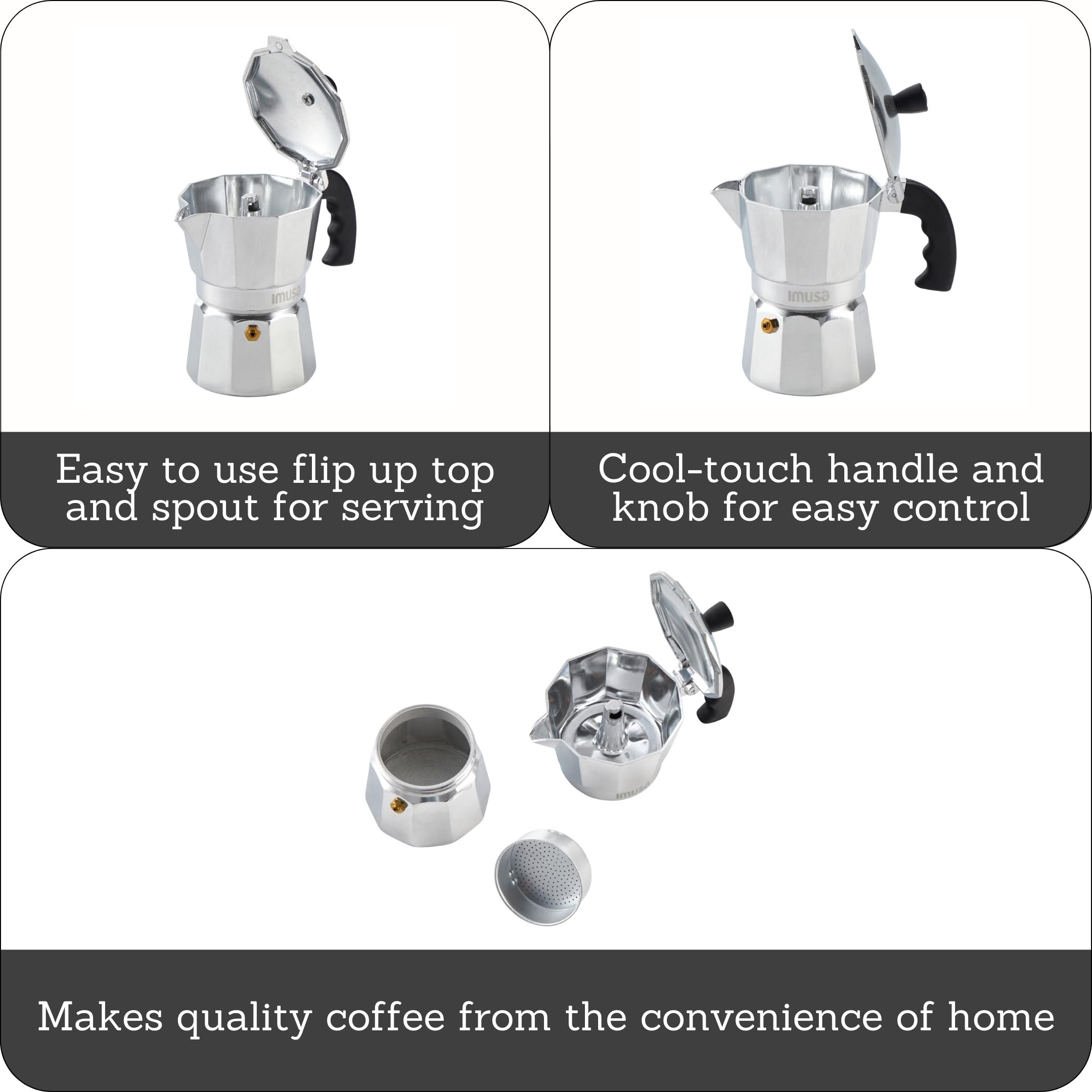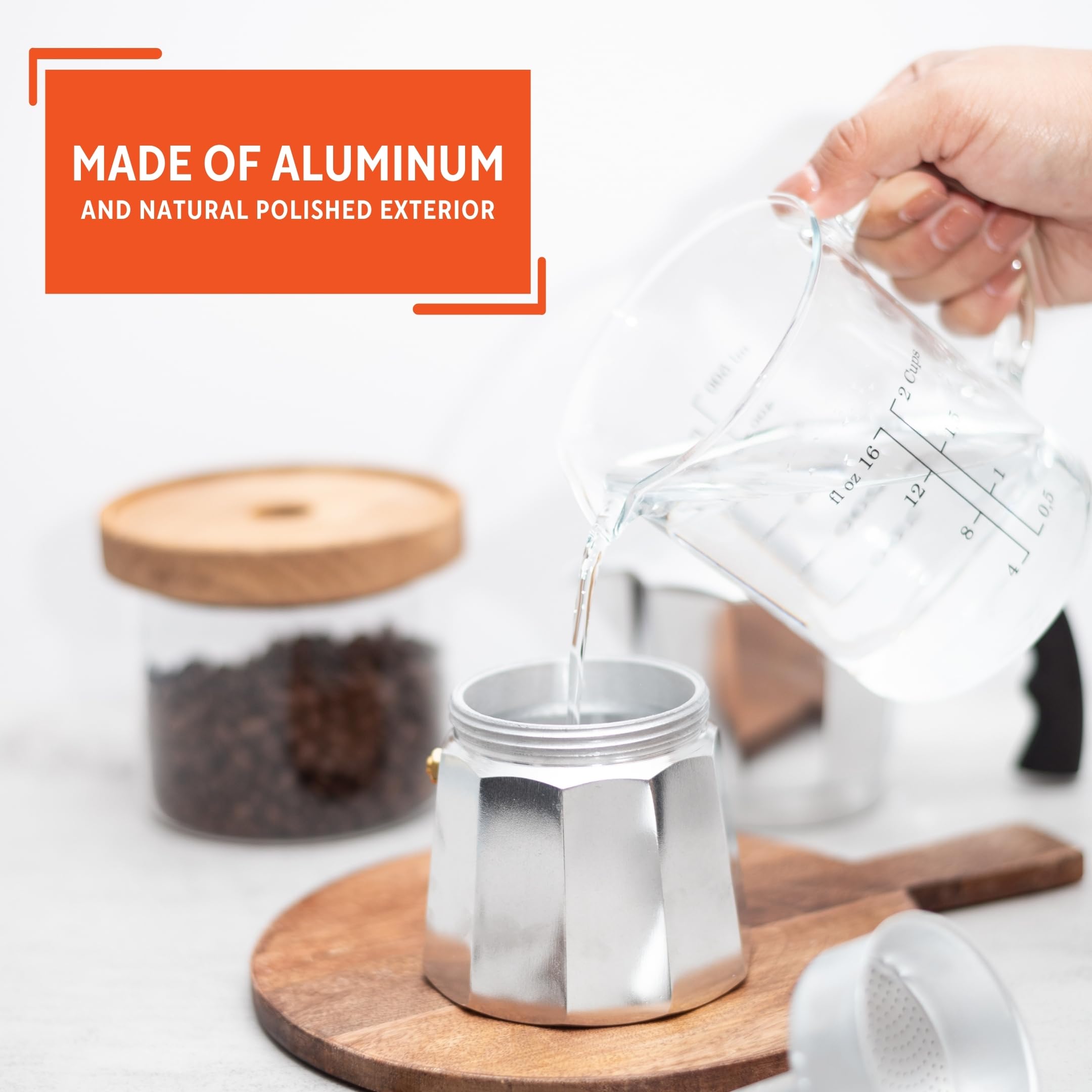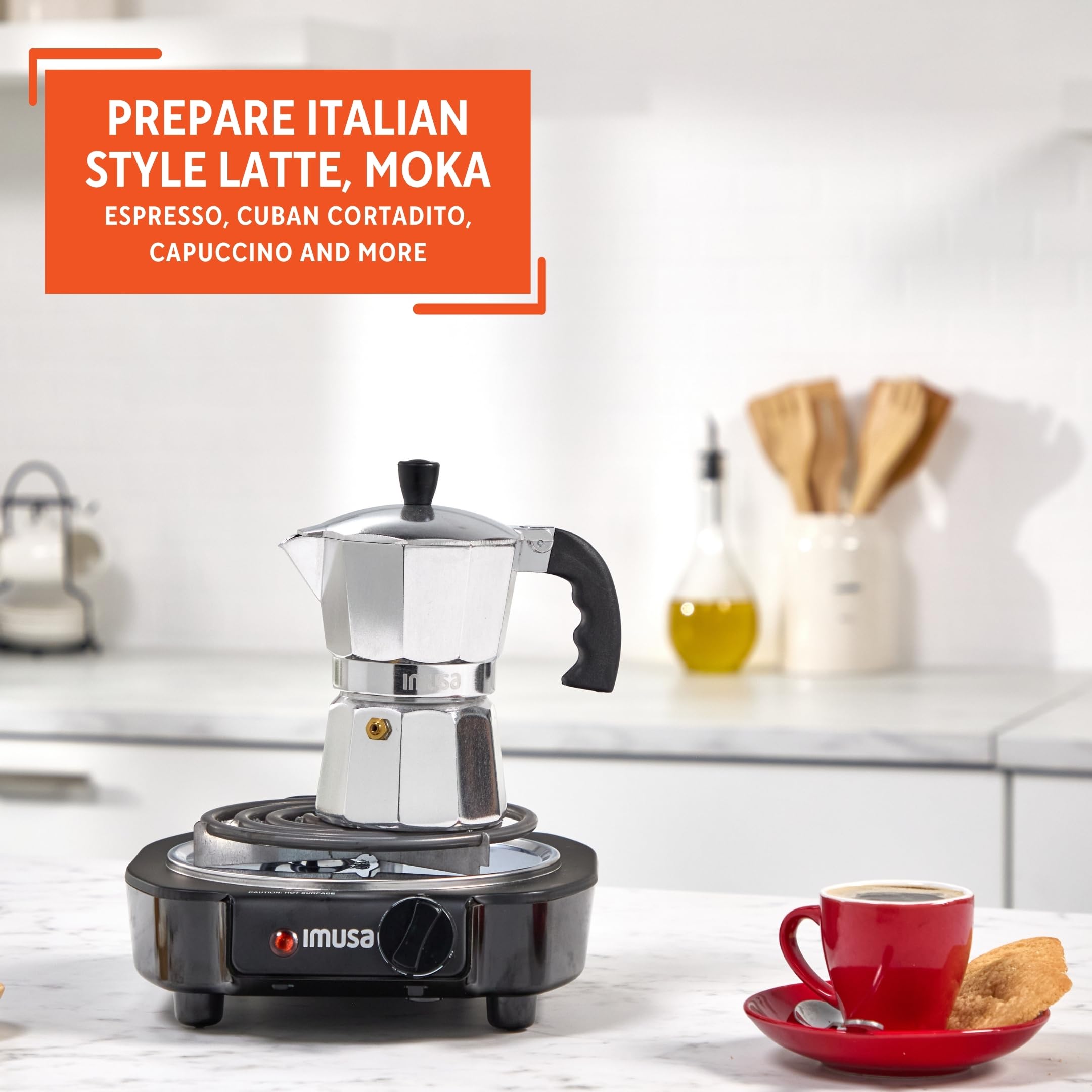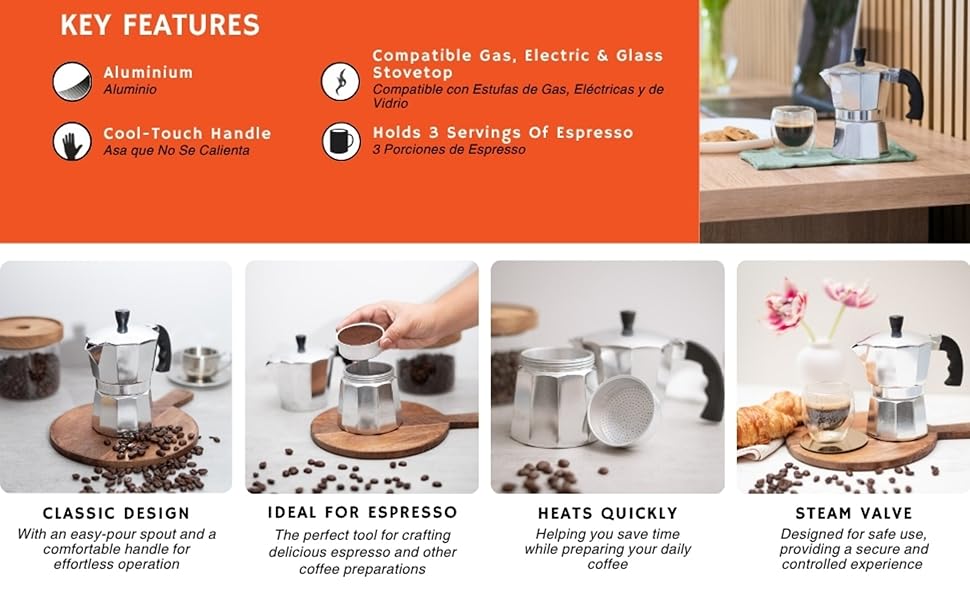Customer Services
Copyright © 2025 Desertcart Holdings Limited
Desert Online General Trading LLC
Dubai, United Arab Emirates










☕ Sip, Share, Savor - Your Espresso Adventure Awaits!
The ImusaUSA B120-42V Aluminum Espresso Stovetop Coffeemaker is a stylish and portable 3-cup espresso maker crafted from durable aluminum. With a cool touch handle and knob, it ensures safe handling while brewing. Its compact design makes it perfect for sharing, and the flip-up top and side pour spout allow for easy serving. Ideal for espresso enthusiasts, this stovetop coffeemaker is easy to clean and maintain, making it a must-have for any coffee lover.



| Exterior Finish | Silver Anodized Aluminum |
| Material | Aluminum |
| Item Weight | 0.65 Pounds |
| Unit Count | 1 1 |
| Number of Items | 1 |
| Item Dimensions D x W x H | 3.9"D x 4.7"W x 6.3"H |
| Capacity | 3 Cups |
| Style | Classic |
| Color | Silver |
| Recommended Uses For Product | Cycling |
| Operation Mode | Manual |
| Voltage | 42 Volts |
| Human Interface Input | Touchscreen |
| Wattage | 120 watts |
| Filter Type | Reusable |
| Specific Uses For Product | Espresso |
| Special Features | Portable,Permanent Filter |
| Coffee Maker Type | Espresso Machine |
T**O
Excellent value – works great on electric stove!
This Italian-style stovetop coffee maker really exceeded my expectations. For the price, the quality is amazing. It works perfectly on my electric stove and brews strong, flavorful coffee just like I wanted. The build feels solid, and the design has a classic look. It's simple to use and easy to clean. Honestly, it’s more than I expected for what I paid. Highly recommended 100%!
J**M
Sometimes century-old tech still works!
First off, this design has literally been around for a century and as such, there are few moving parts, very little complexity, and it doesn't require electricity. This makes it super easy to clean. Second, it is small. Unlike the one I remember my Grandmother using back in the day, this makes 3 cups of espresso, and espresso cups are small. I included a picture for scale.I used to have a regular drip coffee maker, then a smaller version of an espresso/cappuccino like you'd see in a fancy coffee shop, and then settled on a Keurig. That spanned about 30 years of my coffee making history. The Keurig is starting to have scaling problems despite every method I had tried to descale it, and before I bought another to replace it, I thought of getting something like Grandma had. I was skeptical that I was retiring a $100 appliance with a $6 one that could use regular coffee grounds.It's super simple. Unscrew the bottom and fill with water up to (but not covering) the safety valve. Place the funnel that holds the grounds in it and add 2-3 tsp of ground coffee. Screw the top on and put it on the stove. (I set it a little off-center so the handle doesn't get hot on my gas stove.) On medium heat it takes about 4 minutes for it to start brewing, and 30 seconds later you can hear it gurgling, which means it's done. If I'm in an espresso mood, I pour some into a little glass and metal cup. If I want Americano style coffee, I dump the entire contents into a coffee mug and add hot tap water to dilute it down to regular strong coffee.It's cheap to buy, cheap to operate, easy to clean, and easy to use. I no longer leave a Keurig plugged in all day on the chance that I may want a cup of coffee. I don't have to buy wasteful k-cups. I load this with water and grounds, put it under the fire, set the timer for 4 minutes, and go back to what I was doing. When the timer goes off I come back into the kitchen, watch for it to start brewing, and then turn it off a half minute later. Once it starts it brews quickly as the water only passes through the grounds once, unlike perked coffee.If you like a good cup of coffee at home, I suggest giving this a try!16 months later, it's still going strong. It doesn't look as pretty anymore - a combination of daily use for over a year, as well as someone putting it in the dishwasher when I wasn't looking. But it still works great. If I want to speed it up, I let the sink hot water run until it gets piping hot and use that to fill it. With that step I can get the cook time to just under 3 minutes. If you work form home and often just want to make a single cup of espresso or coffee, this is a great way to do it.
A**Y
Not possible to screw up. Super rich and not bitter.
This is BY FAR my favorite way to have coffee. Other methods...trash. Coffee at a cafe...trash. Coffee in a fancy/expensive restaurant...trash. This makes super thick, rich coffee and I have not found a way to screw it up and make it nasty/bitter. Just perfectly made coffee every time. I never knew I could be such a coffee snob!Don't let the cup size discrepancy fool you. It does say 2 cups, but it's more like 1/4 cup. That is fine. Add a bunch of milk (I like 4-6oz soy milk) and it will still taste way stronger than a normal cup of drip coffee
L**R
Great little pot with a few minor flaws
I really do love this little espresso pot! It’s easy to use, brews strong and flavorful coffee, and has become a staple in my morning routine. For the price, it delivers a big bang for the buck — simple, classic design and gets the job done without needing anything fancy.That said, I do wish it came with some kind of mesh insert or filter to help keep the granules out — I’ve noticed a bit of residue in my cup unless I use pre-ground espresso that's super fine. Also, the lid handle tends to come loose more often than I’d like, which can be a little frustrating.Still, those are minor issues for how well it performs overall. It’s a great budget-friendly option for anyone looking to enjoy stovetop espresso at home.
S**W
Secrets to brewing espresso? Are you curious...
The media could not be loaded. This little coffee pot is capable of brewing delicious coffee with a little work and patience you will have a great little coffee maker I have used these for 20+ years I am happy to share what works for me because the directions are vague in places. However there are things that you need to do first before using it to brew your coffee I will explain why. Now If you are not willing to take the time because your lazy, and/or ask for a golden goose during a factory tour whining when factory owner says no your not going to like this coffee maker do yourself a favor give it away as a gift. If you have arthritis or your hands hurt I have arthritis and carpal tunnel just have someone help or just take your time this is not a race. When I pulled this one out of the box I noticed aluminum dust and debris inside and that the threads are a little rough this is to be expected it is not coated this is a cast aluminum aka Pot metal. For many years before the plug and play instant gratification nonsense came about everything you can think of cookware wise was made like this and it was excellent it lasted forever. So I am going to walk you through what I did to make this a good little coffee maker and how to maintain it. First use warm not hot water and normal dishwashing soap along with a non abrasive dishwashing sponge or cotton washcloth or soft bristle nylon brush . Do not use acidic, aggressive, or caustic cleaners its not neccessary and you will ruin your coffee maker. So begin to thoroughly wash/rinse everything inside and out including funnel until all dirt and debris are cleaned out and dry everything with a cotton cloth. Fill the coffee maker with water as the directions specify to the valve and assemble do not add coffee. Now when you assemble the top to the base do not over tighten dont forget your gasket sometimes they fall out just place it back in place. Hold the top and base when tightening not the handle or you will break your handle. As you feel the base make contact with the silicone gasket in the top just tighten snug to seal not over tight this will help seat your gasket. If in doubt about how tight turn until top makes contact with bottom turn until it snugs about a half of an inch extra tighten you don't want to bind your silicone gasket. Place on a burner with the handle away from the burner so it doesn't melt turning heat to medium high while waiting for it to finish the brewing process watch the little brass safety valve it will probably steam a little this is completely normal your valve is working fine. If it leaks between the top and base while percolating remove from heat, allow to cool and tighten a little more when you refill it this sometimes happens dont give up. Pour off the water and allow it to cool this is your first heat cycle a very important part of breaking in your new coffee maker. Absolutely do not cool it off under a faucet with water I know its tempting yet just patiently wait for it to cool on its own down to room temperature for everything to expand contact properly. When it has completely cooled off pull it completely apart again. Looking inside you might see more little black spots or loose debris this is normal rinse and wash them out again as described above. Wipe dry the outside and inside dry with a cotton cloth this prevents water spots and helps loosen any debris. Fill with water to valve again tighten snug not too tight and place it on a burner on medium heat allowing it to run water through watch the pressure relief when finished pour it out allow to completely cool to room temperature completing your second heat cycle. When cool disassemble your coffee maker notice how it comes apart your gasket in the top should seat nicely with the bottom and you shouldn't have any cast debris they should be gone it should look nice and clean inside. Now I will tell you what I do for a delicious cup of espresso. Fill with water using cool or cold filtered water up to the valve, drop in the funnel, add coffee level with the top of funnel loosely no need to tamp, screw on top notice how nicely it seats after all that work, place on burner on medium heat, listening for it to percolate its done when the top is about 3/4 full usually, and pour your espresso into a cup enjoy. It should taste amazing if its too strong or too weak adjust your coffee amount or heating temperature. When finished rinse thoroughly and wipe dry. If you place it in the dishwasher I don't recommend that I made that mistake. Hard water spots happen don't worry about them. With proper cleaning and care this should last for many years. I use these at home, shop, traveling, and they are wonderful on a camping stove. If you notice any yuck on the bottom from a burner or if coffee maker gets nasty dirty inside/outside I clean these with non abrasive white shop hand cleaner buffing it in until dirt is loose, wipe off excess cleaner, wash as described above, and cycle water through it. I have many of these in different sizes all plain aluminum like this. I have polished the outsides of these and and top inside to a beautiful shine with aluminum polish using the same procedure as you do with silverware when I encounter hard water or high mineral water. I have sanded the rough cast inside surface of the base smooth and polished the inside to a mirror shine for fun and easy cleaning. I have busted off or melted off the handles and replaced them with different designs of my own creation. I have Heliarc welded these if they get a seep in the bottom or if the lid hinge breaks/cracks. With care you should be able to pass this on to your children or someone close to you who loves delicious espresso. Hopefully this was helpful for you and you enjoy your espresso maker. If you have any questions just ask me and I will share what has worked for me. Good luck and importantly have fun.
Trustpilot
2 weeks ago
2 weeks ago